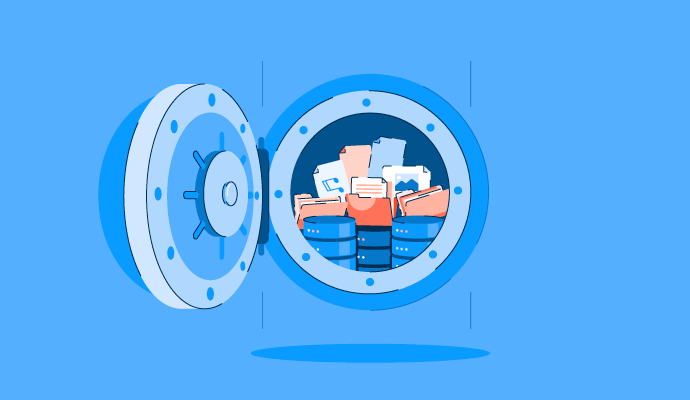September 14, 2023
 by Samudyata Bhat / September 14, 2023
by Samudyata Bhat / September 14, 2023

Every click, swipe, or tap continues a data trail that adds to the vast mosaic of our online world. Maintaining, safeguarding, and organizing our digital valuables becomes increasingly essential.
Archive storage solutions are designed for long-term data preservation. This kind of data isn’t required for day-to-day operations, but it’s retained for commercial or regulatory reasons. Storage solutions, which frequently incorporate data compression, deduplication, and encryption, are meant to be cost-effective while maintaining data integrity.
Data archiving is the method of storing and arranging significant, but currently not in need, information for future reference. Archive data can benefit an organization, or a company may keep it for regulatory compliance.
Digital data adoption takes center stage when innovation is constant and digital information flows like a never-ending river. Managing and protecting this wealth of data becomes critical as our digital footprint expands exponentially.
Like how we put seasonal decorations in a storage room for most of the year to keep a living space tidy, data archiving relocates rarely-used information to a safe location. This makes retrieving vital information easy without clogging up your active storage spaces.
In another scenario, consider your website a treasure trove of material, with each piece of information working as a valuable jewel. As time passes, some of these treasures may become less relevant or accessible but still retain historical significance.
Data archiving systematically stores such less-used but important jewels, guaranteeing that your virtual chest remains orderly and that excess data doesn't slow your website's performance.
A data archiving strategy not only increases the performance of your website but also contributes to preserving your digital history.
Data archiving goals include contributing to effective data management, complying with regulations, preserving digital history, and recovering data from disasters if they occur. Specifically, they concern:
Data storage keeps information close at hand. Data backup is concerned with the speedy recovery of recent, compromised data to ensure business continuity. Finally, while data archiving draws a little bit from storage and a little bit from backup, its main focus is preserving older, less-used data.
Regulatory compliance, optimization, and historical reference are all necessary for effective data management. Storage handles current operating demands, and archiving addresses long-term preservation and resource efficiency.
| Terms | Data Archive | Data Storage | Data Backup |
| Purpose | Transferring historical data to separate storage to optimize resources and ensure long-term preservation | Storing digital information on a storage device, such as hard drives, solid-state drives, or cloud storage | Copying current data to assure its availability in the event of data loss, system failures, or calamities |
| Use case | Used for valuable data that is no longer required for day-to-day activities | Houses active data | Designed to restore data to its most recent condition swiftly |
| Accessibility | Long retrieval times | Readily available | Readily available |
| Data lifecycle | Guarantees that important information is kept in perpetuity, even after it has been removed from operational systems. | Often preserved for a limited time before being erased or moved to another storage device or solution. | The lifecycle of archived data varies based on the protection, size, and recoverability. |
| Software | Archiving storage solutions | Object storage solutions | Backup software solutions |
Data archiving goes beyond simply keeping data around; the practice lets enterprises improve productivity, maintain compliance, make educated decisions, and secure their digital assets for long-term retention.
Here are a few laws and regulations with particular data retention policy requirements to give us a better understanding of data retention's function in compliance.
Data archiving presents several problems businesses must overcome to successfully manage their stored data. Below are five issues you might have to figure out.
You have to have a plan for data archiving as a crucial component of your data lifecycle management policy. It allows you to save information and maintain a realistic storage budget simultaneously.
Tip: A data archival strategy improves the performance of critical resources in your active system, allowing users to immediately access data archive storage devices or plans for easier retrieval and more cost-effective data preservation.
The following are the top five recommended techniques for building a strong data archival strategy.
Create well-defined archiving policies that specify the kind of data to preserve and parameters for when it should be archived and how long it should be kept. Implement data eligibility criteria to maintain consistency and compliance with rules.
Categorize data by its value, sensitivity, and frequency of use. Not every data point requires the same level of preservation. Prioritize data archiving based on business demands, regulatory constraints, and historical importance.
Set up encryption, access controls, and authentication systems to ensure preserved data security. Audit and monitor access to archived data regularly to avoid illegal access.
Choose archiving systems that can handle expanding data volumes. Consider applying cost-effective storage such as tape archives or cloud archiving systems to manage fees.
Keep thorough records of your data archiving operations, including rules, methods, and reasoning behind data archiving choices. This documentation comes in handy for audits, ensures consistency, and functions as a reference for future decision-making.
Archive storage solutions typically keep emails, documents, and other data that aren’t immediately relevant, but still have value for historical reference, compliance, or data recovery. These systems can support physical storage, such as tapes, and digital storage, such as cloud-based services.
* Above are the five leading archive storage solutions as per G2’s scores.

Data archiving emerges as a steady custodian of information in the fabric of our digital era, maintaining the threads of history, compliance, and efficiency. As we weave through the currents of innovation, we discover that data archiving protects our history and steers our future. It lets us make educated judgments, navigate regulatory environments, and optimize resources.
As technology advances, the significance of appropriate data preservation and protection will stay constant, providing a link between the well-known past and the undiscovered territory ahead.
Seize the opportunity and discover more about data protection!
Samudyata Bhat is a Content Marketing Specialist at G2. With a Master's degree in digital marketing, she currently specializes her content around SaaS, hybrid cloud, network management, and IT infrastructure. She aspires to connect with present-day trends through data-driven analysis and experimentation and create effective and meaningful content. In her spare time, she can be found exploring unique cafes and trying different types of coffee.
With rapidly advancing technology and increasingly high user expectations, companies must...
 by Samudyata Bhat
by Samudyata Bhat
Imagine you are the CEO of a company, delivering cloud data management and data security...
 by Meenakshi Arora
by Meenakshi Arora
Filing cabinets are obsolete. So are storage silos and reactive backup plans.
 by Samudyata Bhat
by Samudyata Bhat
With rapidly advancing technology and increasingly high user expectations, companies must...
 by Samudyata Bhat
by Samudyata Bhat
Imagine you are the CEO of a company, delivering cloud data management and data security...
 by Meenakshi Arora
by Meenakshi Arora


